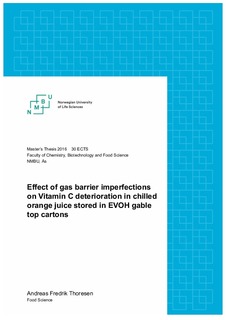| dc.contributor.advisor | Pettersen, Marit Kvalvåg | |
| dc.contributor.advisor | Dybvik, André | |
| dc.contributor.advisor | Larsen, Hanne | |
| dc.contributor.author | Thoresen, Andreas Fredrik | |
| dc.date.accessioned | 2017-05-24T13:16:04Z | |
| dc.date.available | 2017-05-24T13:16:04Z | |
| dc.date.issued | 2016 | |
| dc.identifier.uri | http://hdl.handle.net/11250/2443471 | |
| dc.description.abstract | Gas barrier imperfections in gable top cartons can lead to oxygen from the ambience permeating a carton, causing deterioration of vitamin C in fruit juices. Barrier imperfections in relation to vitamin C in orange juice have not yet been investigated in any scientific paper. Neither have imperfections in the gas barrier in Ethylene Vinyl Alcohol (EVOH)- or aluminum barrier cartons in relation to oxygen Transfer Rate (OTR) been investigated in a scientific paper.
In this thesis, gable top cartons with an EVOH or an aluminum gas barrier was investigated to find the effect barrier imperfections had on deterioration of vitamin C in chill stored orange juice. This project attempted to quantify and describe gas barrier imperfections in the gas barrier in gable top cartons with available methods and investigate if there was a relation to degradation of vitamin C in orange juice, and to develop a practical method for measuring OTR of a gable top carton with perforations with the Ambient oxygen Ingress Rate (AOIR)-method.
Perforations and barrier imperfections were generated in the gas barrier in gable top cartons and the cartons filled with juice. During storage for 8 weeks, sampling investigated headspace oxygen concentration, dissolved oxygen content in the juice and vitamin C deterioration. Cartons were also tested with dye-testing and investigated in microscope to describe gas barrier imperfections. Also, a practical method for measuring OTR of a gable top carton with the AOIR-method was developed.
Aluminum barrier cartons retained more vitamin C than EVOH barrier cartons. Some, but not all seal barrier imperfections affected vitamin C degradation in orange juice. Of the 7 different perforations generated in EVOH cartons, 4 did not have statistically different vitamin C content than a reference without perforations, after 8 weeks.
Dissolved oxygen does not equalize in orange juice, as there was measured a higher concentration in the top of the orange juice and less in the bottom, creating a gradient in the juice. The area of color penetration from a dye test did not correlate with vitamin C content or OTR. Neither did vitamin C deterioration correlate with OTR measured with AOIR. An EVOH gable top carton does not have to be free of barrier imperfections to retain vitamin C content in orange juice, as certain perforations did not cause greater deterioration of vitamin C. Further work is needed to complete and validate the AOIR method for use in Cartons. | nb_NO |
| dc.language.iso | eng | nb_NO |
| dc.publisher | Norwegian University of Life Sciences, Ås | nb_NO |
| dc.rights | Attribution-NonCommercial-NoDerivatives 4.0 Internasjonal | * |
| dc.rights.uri | http://creativecommons.org/licenses/by-nc-nd/4.0/deed.no | * |
| dc.title | Effect of gas barrier imperfections on Vitamin C deterioration in chilled orange juice stored in EVOH gable top cartons | nb_NO |
| dc.type | Master thesis | nb_NO |
| dc.source.pagenumber | 47 | nb_NO |
| dc.description.localcode | M-MAT | nb_NO |

